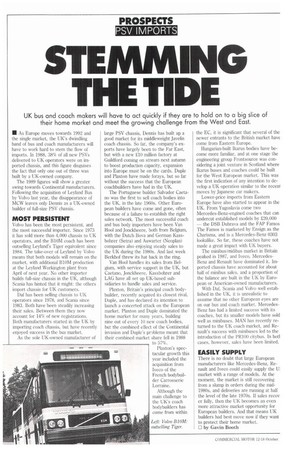ST ENUVIING TH E TIDE
Page 34

If you've noticed an error in this article please click here to report it so we can fix it.
UK bus and coach makers will have to act quickly if they are to hold on to a big slice of their home market and meet the growing challenge from the West and East.
• As Europe moves towards 1992 and the single market, the UK's dwindling band of bus and coach manufacturers will have to work hard to stem the flow of imports. In 1988, 38% of all new PSVs delivered to UK operators were on imported chassis, and this figure disguises the fact that only one out of three was built by a UK-owned company.
The 1989 figures will show a greater swing towards Continental manufacturers. Following the acquisition of Leyland Bus by Volvo fast year, the disappearance of MCW leaves only Dennis as a UK-owned builder of full-size PSV chassis.
MOST PERSISTENT
Volvo has been the most persistent, and the most successful importer. Since 1973 it has sold more than 4,000 chassis to UK operators, and the BI OM coach has been outselling Leyland's Tiger equivalent since 1984. The take-over of Leyland by Volvo means that both models will remain on the market, with additional 1310M production at the Leyland Workington plant from April of next year. No other importer builds full-size chassis in the UK, although Scania has hinted that it might: the others import chassis for UK customers.
Dal has been selling chassis to UK operators since 1978, and Scania since 1983. Both have been steadily increasing their sales. Between them they now account for 14% of new registrations. Both manufacturers started in the UK by importing coach chassis, but have recently enjoyed success in the bus market.
As the sole UK-owned manufacturer of large PSV chassis, Dennis has built up a good market for its middleweight Javelin coach chassis. So far, the company's exports have largely been to the Far East, but with a new million factory at Guildford coming on stream next autumn to boost production capacity, expansion into Europe must be on the cards. Duple and Plaxton have made forays, but so far without the success that the European coachbuilders have had in the UK.
The Portuguese builder Salvador Caetano was the first to sell coach bodies into the UK, in the late 1960s. Other European builders have come and gone, often because of a failure to establish the right sales network. The most successful coach and bus body importers have been Van Hool and Jonckheere, both from Belgium, with the Dutch Bova and German Kassbohrer (Setra) and Auwarter (Neoplan) companies also enjoying steady sales to the UK during the 1980s, And last week Berkhof threw its hat back in the ring.
Van Hool handles its sales from Belgium, with service support in the UK, but Caetano, Jonckheere, Kassbohrer and LAG have all set up UK-based subsidiaries to handle sales and service.
Plaxton, Britain's principal coach bodybuilder, recently recently acquired its closest rival. Duple, and has declared its intention to launch a concerted attack on the European market. Plaxton and Duple dominated the home market for many years, building nine out of every 10 new coach bodies, but the combined effect of the Continental invasion and Duple's problems meant that their combined market share fell in 1988 to 57%.
Piaxton's spectacular growth this year included the acquisition from Iveco of the French bodybuilder Carrosserie Lorraine.
Although the main challenge to the UK's coach bodybuilders has come from within the EC, it is significant that several of the newer entrants to the British market have come from Eastern Europe.
Hungarian-built Ikarus bodies have become more familiar, and at one stage the engineering group Frontsource was considering a joint venture in Scotland where Ikarus buses and coaches could he built for the West European market. This was the first indication of any intention to develop a UK operation similar to the recenl moves by Japanese car makers.
Lower-price imports from Eastern Europe have also started to appear in the UK. From Yugoslavia come two Mercedes-Benz-engined coaches that can undercut established models by £20,000 — the DSB Dubrava and the FAP Famos. The Famos is marketed by Ensign as the Charisma, and is a Mercedes-Benz 0303 iookalike. So far, these coaches have not made a great impact with UK buyers.
The minibusimidibus market in Britain peaked in 1987, and Iveco, MercedesBenz and Renault have dominated it. Imported chassis have accounted for about half of minibus sales, and a proportion of the balance are built in the UK by European or American-owned manufacturers.
With Daf, Scania and Volvo well established in the UK, it is unrealistic to assume that no other European eyes are on our bus and coach market. MercedesBenz has had a limited success with its coaches, but its smaller models have sold well as minibuses. MAN has recently returned to the UK coach market, and Renault's success with minibuses led to the introduction of the PR1(X) citybus. In botl cases, however, sales have been limited.
EASILY SUPPLY
There is no doubt that large European manufacturers like Mercedes-Benz, Renault and Iveco could easily supply the U! market with a range of models. At the moment, the market is still recovering from a slump in orders during the mid1980s, and deliveries are running at half the level of the late 1970s. If sales recov er fully, then the UK becomes an even more attractive market opportunity for European builders. And that means UK builders had best move now if they want to protect their home market.
0 by Gavin Booth
































































































































